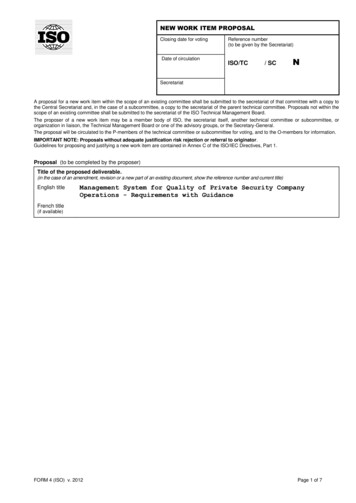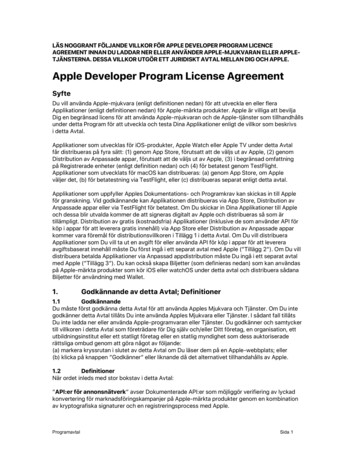
Transcription
NEW WORK ITEM PROPOSALClosing date for votingDate of circulationReference number(to be given by the Secretariat)ISO/TC/ SCNSecretariatA proposal for a new work item within the scope of an existing committee shall be submitted to the secretariat of that committee with a copy tothe Central Secretariat and, in the case of a subcommittee, a copy to the secretariat of the parent technical committee. Proposals not within thescope of an existing committee shall be submitted to the secretariat of the ISO Technical Management Board.The proposer of a new work item may be a member body of ISO, the secretariat itself, another technical committee or subcommittee, ororganization in liaison, the Technical Management Board or one of the advisory groups, or the Secretary-General.The proposal will be circulated to the P-members of the technical committee or subcommittee for voting, and to the O-members for information.IMPORTANT NOTE: Proposals without adequate justification risk rejection or referral to originator.Guidelines for proposing and justifying a new work item are contained in Annex C of the ISO/IEC Directives, Part 1.Proposal (to be completed by the proposer)Title of the proposed deliverable.(in the case of an amendment, revision or a new part of an existing document, show the reference number and current title)English titleManagement System for Quality of Private Security CompanyOperations - Requirements with GuidanceFrench title(if available)FORM 4 (ISO) v. 2012Page 1 of 7
New work item proposalScope of the proposed deliverable.This proposed International Standard (Standard) provides the principles andrequirements for a Quality Assurance Management System (QAMS) for Private SecurityService Providers including Private Security Companies (collectively “PSCs”) toprovide quality assurance in all security related activities and functions whiledemonstrating accountability to law and respect for human rights. The Standardprovides auditable criteria and guidance consistent with the “Montreux Document onPertinent International Legal Obligations and Good Practices for States related toOperations of Private Military and Security Companies during Armed Conflict” of 17September 2008 and the “International Code of Conduct for Private Security ServiceProviders” (ICoC) of 9 November 2010. This Standard provides a means for PSCs, andtheir clients, to provide demonstrable commitment and conformance with the aims ofthe Montreux Document and the principles outlined in the ICoC, as well as enhancethe security and protection of stakeholders.This Standard provides a framework for establishing, implementing, operating,monitoring, reviewing, maintaining and improving the management of their productsand services. It is particularly applicable for any type of land-based PSCoperating in circumstances of weakened governances where the rule of law has beenundermined due to human or naturally caused events.This Standard is applicable to any PSC that needs to:a) Establish, implement, maintain, and improve a QAMS;b) Assess its conformity with its stated quality assurance managementpolicy;c) Demonstrate its ability to consistently provide services that meetclient needs and are in conformance with applicable international law,local laws and human rights requirements;d) Demonstrate conformity with this Standard by:I.II.Making a self-determination and self-declaration;Seeking confirmation of its conformance by parties having aninterest in the organization (such as clients);III.Seeking confirmation of its self-declaration by a party externalto the organization; orIV.Seeking certification/registration of its QAMS by an independentand accredited external organization.The generic principles and requirements of this Standard are intended to beincorporated into any organization’s management system based on the PDCA model; itis not intended to promote a uniform approach to all organizations in all sectors.The design and implementation of quality assurance plans, procedures and practicesshould take into account the particular requirements of each organization: itsobjectives, context, culture, structure, resources, operations, processes, productsand services.Note: The International Code of Conduct for Private Security Service Providers”(ICoC) (Section One) defines Private Security Companies and Private SecurityService Providers as “any Company (as defined in this Code) whose businessactivities include the provision of security services either on its own behalf oron behalf of another, irrespective of how such Company describes itself”. In thisStandard, a distinction is made between Private Military Companies (PMCs) whichwork in military and conflict settings to offer direct tactical military assistanceand land-based Private Security Companies (PSCs). This Standard ONLY applies toPSCs and DOES NOT apply to PMCs.FORM 4 (ISO) v. 2012Page 2 of 7
New work item proposalIf a draft is attached to this proposal,:Please select from one of the following options (note that if no option is selected, the default will be the firstoption):Draft document will be registered as new project in the committee's work programme (stage 20.00)Draft document can be registered as a Working Draft (WD – stage 20.20)Draft document can be registered as a Committee Draft (CD – stage 30.00)Draft document can be registered as a Draft International Standard (DIS – stage 40.00)Is this a Management Systems Standard (MSS)?YesNoIndication(s) of the preferred type or types of deliverable(s) to be produced under the proposal.International StandardTechnical SpecificationProposed development track 1 (24 months)Publicly Available Specification2 (36 months - default)Technical Report 3 (48 months)Known patented items (see ISO/IEC Directives, Part 1 for important guidance)YesNoIf "Yes", provide full information as annexA statement from the proposer as to how the proposed work may relate to or impact on existing work, especiallyexisting ISO and IEC deliverables. The proposer should explain how the work differs from apparently similar work,or explain how duplication and conflict will be minimized.There is no potential overlap or conflict with other existing or plannedISO or non-ISO international standards, or those at the national orregional level, as there are no initiatives on any of these levels todevelop a MSS to address private security service providers engaged inland-based operations. The work is proposed to be conducted by a ProjectCommitee given that ISO currently does not have any technical committeesthat address issues related to the provision of private security services,particularly armed security services. Nor do any current ISO technicalcommittees contain the breadth of expertise from client, service providerand civil society communities necessary to successfully develop thisStandard.FORM 4 (ISO) v. 2012Page 3 of 7
New work item proposalA listing of relevant existing documents at the international, regional and national levels.The relevant reference materials are:1) Montreux Document On Pertinent International Legal Obligations and GoodPractices for States Related to Operations of Private Military and SecurityCompanies During Armed Conflict (09/2008);2) International Code of Conduct for Private Security Service Providers (ICoC)(11/2010);3) ANSI/ASIS.PSC.1:2012 Management System for Quality of Private Security CompanyOperations - Requirements with Guidance;4) ANSI/ASIS.PSC.2:2012 Conformity Assessment and Auditing Management Systems forQuality of Private Security Company Operations;5) ISO 31000:2009, Risk management – Principles and guidelines.Relevant documents relating to United Nations and International Human Rightspublications are extensively referenced in the bibliography ofANSI/ASIS.PSC.1:2012.No other national or international standards have been developed to address theissues addressed in this proposed standard.FORM 4 (ISO) v. 2012Page 4 of 7
New work item proposalA simple and concise statement identifying and describing relevant affected stakeholder categories (including smalland medium sized enterprises) and how they will each benefit from or be impacted by the proposed deliverable(s)Given the sensitive nature of the subject, it was important to assure balance ofthe stakeholders; therefore, the technical committee needs to be evenly balancedwith equal representation of: 1/3 Clients and users of security services (governmental and non-governmentalincluding NGOs, development and relief organizations, mining and extractioncompanies, businesses, etc.) 1/3 Providers of security services (large, medium and small enterprises) 1/3 Civil society, international humanitarian law and human rights organizations(including NGOs, international lawyers, academics, rights advocates, communitygroups, etc.)A large pool of technical experts who are direct representatives of the affectedparties from the different geographical regions have been identified andcontributed to the efforts to develop the ANSI/ASIS PSC series of standards. Thesestakeholders would likewise be identified for the ISO process.The sanctity of human life is the paramount underlying principle of this Standard.PSCs, and their clients, have an obligation to protect the lives and safety of bothinternal and external stakeholders (including the community at large). By usingthis Standard, PSCs can better understand the risks they face and preemptivelydevelop strategies that will:a) Manage risk posed to the lives and property of those whom they are contractuallyobligated to protect;b) Support the objectives of the Montreux Document on Pertinent International LegalObligations and Good Practices for States related to Operations of Private Militaryand Security Companies during Armed Conflict and the International Code of Conductfor Private Security Service Providers (ICoC);c) Demonstrate commitment, conformance, and accountability to respect human rights,laws, and fundamental freedoms;d) Reduce risk and support the business and operational mission; ande) Successfully manage an undesirable or disruptive event by developing a strategyand action plans to safeguard its interest and those of its clients and otherstakeholders.FORM 4 (ISO) v. 2012Page 5 of 7
New work item proposalLiaisons:Joint/parallel work:A listing of relevant external international organizationsor internal parties (other ISO and/or IEC committees) tobe engaged as liaisons in the development of thedeliverable(s).Possible joint/parallel work with: Amnesty International ASIS International Geneva Academy of InternationalHumanitarian Law and Human Rights Geneva Centre for the DemocraticControl of Armed Forces (DCAF)IEC(please specify committee ID)CEN(please specify committee ID)Other(please specify) This proposalrelates to the adoption by ISO of anexisting standard at the DIS levelwithin the framework of a ProjectCommittee. International Committee of the RedCross (ICRC) International Institute forHumanitarian Law (IIHL) International Stability OperationsAssociation (ISOA) Pan African Security Association(PASA) Security Association for the MaritimeIndustry (SAMI) Security in Complex EnvironmentsGroup (UK industry association) The Fund for Peace United Nations ISO/TC 8 Ships and MaritimeTechnology ISO/TC 176 Quality Management ISO/TC 262 Risk ManagementA listing of relevant countries which are not already P-members of the committee.It is proposed the work be conducted by a Project Committee. The technicalcommittee that developed the ANSI/ASIS.PSC.1:2012 was comprised of more than 200experts from 24 countries. There are 42 Signatory Countries to the MontreuxDocument and 464 Signatory Companies from 60 countries to the ICoC. These would beapproached to participate in the Project Committee.Preparatory work (at a minimum an outline should be included with the proposal)A draft is attachedAn outline is attachedAn existing document to serve as initial basisThe proposer or the proposer's organization is prepared to undertake the preparatory work requiredProposed Project Leader (name and e-mail address)Dr. Marc Siegel siegel@msiegel.net FORM 4 (ISO) v. 2012YesNoName of the Proposer(include contact information)ANSIPage 6 of 7
New work item proposalSupplementary information relating to the proposalThis proposal relates to a new ISO document;This proposal relates to the amendment of existing ISO documentThis proposal is for the revision of an existing ISO document;This proposal relates to the adoption as an active project of an item currently registered as a Preliminary Work Item;This proposal relates to the re-establishment of a cancelled project as an active project.Other:This proposal relates to the adoption by ISO of an existing standardwithin the framework of a PSDO agreementAnnex(es) are included with this proposal (give details)ANSI/ASIS.PSC.1:2012 Management System for Quality of Private Security CompanyOperations - Requirements with GuidanceDate of submissionFORM 4 (ISO) v. 2012Page 7 of 7
ISO/TC / SC N Secretariat A proposal for a new work item within the scope of an existing committee shall be submitted to the secretariat of that commit tee with a copy to the Central Secretariat and, in the case o f a subcommittee, a copy to the secretariat of the parent technical committee. . ISO/TC 176 Quality Management ISO/TC 262 .











